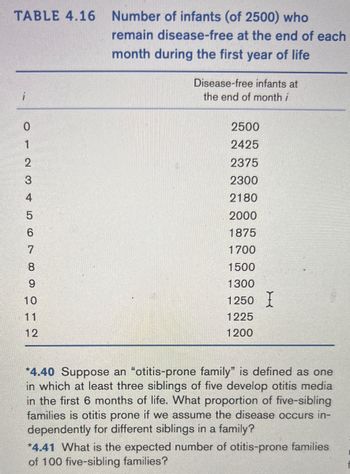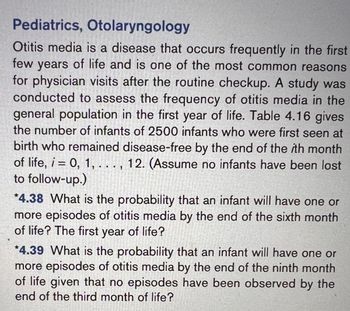
MATLAB: An Introduction with Applications
6th Edition
ISBN: 9781119256830
Author: Amos Gilat
Publisher: John Wiley & Sons Inc
expand_more
expand_more
format_list_bulleted
Question
Please answer only 4.41

Transcribed Image Text:**TABLE 4.16**
**Number of infants (of 2500) who remain disease-free at the end of each month during the first year of life**
| i | Disease-free infants at the end of month *i* |
|----|----------------------------------------------|
| 0 | 2500 |
| 1 | 2425 |
| 2 | 2375 |
| 3 | 2300 |
| 4 | 2180 |
| 5 | 2000 |
| 6 | 1875 |
| 7 | 1700 |
| 8 | 1500 |
| 9 | 1300 |
| 10 | 1250 |
| 11 | 1225 |
| 12 | 1200 |
**Discussion:**
The table shows the number of infants who remain disease-free from a cohort of 2500, tracked over the first year of life, at monthly intervals.
**Questions:**
*4.40* Suppose an “otitis-prone family” is defined as one in which at least three siblings of five develop otitis media in the first 6 months of life. What proportion of five-sibling families is otitis prone if we assume the disease occurs independently for different siblings in a family?
*4.41* What is the expected number of otitis-prone families of 100 five-sibling families?

Transcribed Image Text:**Pediatrics, Otolaryngology**
Otitis media is a disease that occurs frequently in the first few years of life and is one of the most common reasons for physician visits after the routine checkup. A study was conducted to assess the frequency of otitis media in the general population in the first year of life. Table 4.16 gives the number of infants of 2500 infants who were first seen at birth who remained disease-free by the end of the *i*th month of life, *i* = 0, 1, . . . , 12. (Assume no infants have been lost to follow-up.)
**Exercise 4.38:** What is the probability that an infant will have one or more episodes of otitis media by the end of the sixth month of life? The first year of life?
**Exercise 4.39:** What is the probability that an infant will have one or more episodes of otitis media by the end of the ninth month of life given that no episodes have been observed by the end of the third month of life?
Expert Solution
This question has been solved!
Explore an expertly crafted, step-by-step solution for a thorough understanding of key concepts.
This is a popular solution
Trending nowThis is a popular solution!
Step by stepSolved in 4 steps

Knowledge Booster
Similar questions
- 3 divided by 3.20arrow_forwardCharlotte is driving at 74.6 mi/h74.6 mi/h and receives a text message. She looks down at her phone and takes her eyes off the road for 3.88 s.3.88 s. How far has Charlotte traveled in feet during this time?arrow_forward17 AG 45 and VA = 40. What is TO? Roumd to the nearest whole number. %3D @ 150 B 75 ©72 D 60 Aarrow_forward
- A certain medicine requires 5 mg per 20 kg of weight. How much medicine is required for a patient that weighs 196 pounds? Round answer to the nearest 10th.arrow_forwardThe power for a circuit is 1,265.75 watts. Seven equal units use this amount of power. Find the number of watts to the nearest hundredth used per unit.arrow_forward0.565 miles = how many feet?arrow_forward
- convert 8 kilometers to yards and round to the nearest 10tharrow_forwardthe label on a gallon of paint claims the gallon will cover seventy-five square feet. How many one gallon cans will be needed to paint the Wall? Area of the walls are 391 5/9 unitsarrow_forwardA car is driving at 75 kilometers per hour. How far, in meters, does it travel in 5 seconds? metersarrow_forward
- Ms. Silva earns 19$ per hour. She earns 20,710$ this year. How many hours deos ma. Silva work this year?arrow_forwardExpress 86 ounces as pounds. Round the answer to the same number of significant digits as in the original quantity.arrow_forwardThe fastest 50-yard dash was completed in 5.11 seconds. To the nearest hundredth, how many hours was this man traveling? (1 mile=5,280 feet, 1 yard= 3 feet)arrow_forward
arrow_back_ios
arrow_forward_ios
Recommended textbooks for you
 MATLAB: An Introduction with ApplicationsStatisticsISBN:9781119256830Author:Amos GilatPublisher:John Wiley & Sons Inc
MATLAB: An Introduction with ApplicationsStatisticsISBN:9781119256830Author:Amos GilatPublisher:John Wiley & Sons Inc Probability and Statistics for Engineering and th...StatisticsISBN:9781305251809Author:Jay L. DevorePublisher:Cengage Learning
Probability and Statistics for Engineering and th...StatisticsISBN:9781305251809Author:Jay L. DevorePublisher:Cengage Learning Statistics for The Behavioral Sciences (MindTap C...StatisticsISBN:9781305504912Author:Frederick J Gravetter, Larry B. WallnauPublisher:Cengage Learning
Statistics for The Behavioral Sciences (MindTap C...StatisticsISBN:9781305504912Author:Frederick J Gravetter, Larry B. WallnauPublisher:Cengage Learning Elementary Statistics: Picturing the World (7th E...StatisticsISBN:9780134683416Author:Ron Larson, Betsy FarberPublisher:PEARSON
Elementary Statistics: Picturing the World (7th E...StatisticsISBN:9780134683416Author:Ron Larson, Betsy FarberPublisher:PEARSON The Basic Practice of StatisticsStatisticsISBN:9781319042578Author:David S. Moore, William I. Notz, Michael A. FlignerPublisher:W. H. Freeman
The Basic Practice of StatisticsStatisticsISBN:9781319042578Author:David S. Moore, William I. Notz, Michael A. FlignerPublisher:W. H. Freeman Introduction to the Practice of StatisticsStatisticsISBN:9781319013387Author:David S. Moore, George P. McCabe, Bruce A. CraigPublisher:W. H. Freeman
Introduction to the Practice of StatisticsStatisticsISBN:9781319013387Author:David S. Moore, George P. McCabe, Bruce A. CraigPublisher:W. H. Freeman

MATLAB: An Introduction with Applications
Statistics
ISBN:9781119256830
Author:Amos Gilat
Publisher:John Wiley & Sons Inc

Probability and Statistics for Engineering and th...
Statistics
ISBN:9781305251809
Author:Jay L. Devore
Publisher:Cengage Learning

Statistics for The Behavioral Sciences (MindTap C...
Statistics
ISBN:9781305504912
Author:Frederick J Gravetter, Larry B. Wallnau
Publisher:Cengage Learning

Elementary Statistics: Picturing the World (7th E...
Statistics
ISBN:9780134683416
Author:Ron Larson, Betsy Farber
Publisher:PEARSON

The Basic Practice of Statistics
Statistics
ISBN:9781319042578
Author:David S. Moore, William I. Notz, Michael A. Fligner
Publisher:W. H. Freeman

Introduction to the Practice of Statistics
Statistics
ISBN:9781319013387
Author:David S. Moore, George P. McCabe, Bruce A. Craig
Publisher:W. H. Freeman